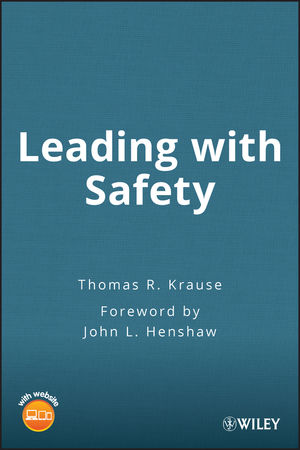Leading with SafetyISBN: 978-0-471-49425-6
Hardcover
304 pages
November 2005
 This is a Print-on-Demand title. It will be printed specifically to fill your order. Please allow an additional 15-20 days delivery time. The book is not returnable.
|
||||||
Foreword by John L Henshaw xiii
Preface xvii
Acknowledgments xxi
Introduction
Safety as metaphor for organizational excellence 1
Section 1: The Organizational Safety Model 5
1. The Organizational Safety Model 7
How safety leadership assures improvement 8
The primary importance of the Working Interface 10
Understanding the relationship of exposure events to injury events 11
The necessity of leading indicators 14
Enabling safety systems 15
Sustaining safety systems 16
Leadership creates organizational culture and safety climate 16
What motivates leaders to improve safely? 18
Influencing the behavior of safety leaders 19
Sustaining organizational change: Two critical elements 20
Section 2: The Safety Leadership Model 23
2. The Safety Leadership Model, Part 1
The personality, values, emotional commitment, and leadership style of the effective safety leader 25
The core elements: personality, values, and emotional commitment 27
Measurement of the Big Five 30
Applications of Big Five research to safety leadership 31
Using the findings to improve safely leadership 32
How leaders use the Big Five to improve safety effectiveness 34
The leader’s values and emotional commitment to safety 35
Leadership style: transactional and transformational 38
Cultivating style 43
3. The Safety Leadership Model, Part 2
Best practices in safety leadership 45
Tire central role of leadership in safety 46
Leadership vs. management 47
Best practices in safety leadership 48
Measuring leadership best practices 57
4. The Safety Leadership Model, Part 3
Understanding organizational culture and safety climate 59
Primary dimensions of organizational culture and safety climate 61 Why some organizations respond to change more readily 62
The Organizational Culture Diagonostic Instrument (OCDI) 67
The Organization Dimension 68
The Team Dimension 75
The Safety-Specific Dimension 77
Section 3: The Leader's Role: Understanding two crucial aspects of human performance 83
5. Changing Behavior Using Applied Behavior Analysis 85
Applied behavior analysis in organizational settings 86
How applied behavior analysis supports safety improvement 87
Central concepts: antecedents, behavior, consequences 88
ABC Analysis as a tool 91
Example 1: Changing behavior at the leadership level 91
Considerations for identifying new consequences 93
Example 2: Changing behavior at the middle management level 97
Putting behavior analysis to work 101
6. The Effect of Cognitive Bias on Safety Decisions 103
Research findings on cognitive bias 104
Tragedy on Mount Everest in 1996 105
Applications to the organizational safety leader 107
Understanding cognitive bias 108
A manufacturing safety example 109
Putting knowledge of cognitive bias to work 110
Section 4: Engaging Employees H3
7. The Role of Executive Coaching in Leadership Development 115
Executive coaching: from remedial to developmental 116
A behavioral approach to leadership 116
The coaching process: Behavioral and contextual 118
Step One: Understanding the context 118
Step Two: Clarifying the client’s unique point of view 119
Step Three: Gathering the data and writing a report 120
Step four: The plan 122
Step Five: Implementing the plan 123
Step Six: Assessing the impact 123
Coaching for safety leadership 124
8. The Role of the Supervisor in Leading with Safety 129
The pivotal role of the first-line supervisor 130
Communication skills — the foundation 131
The power of strong working relationships 133
Fair decision-making and its effects 135
Alignment: Incorporating organizational values and priorities into day-to-day activities 137
Safety contacts: Getting an accurate picture of performance 138
9. A Systematic Process for Reducing Exposure to Hazards:
What the safety improvement process looks like at the worker level 141
Engagement and cooperation 142
Getting engaged in safety 145
The safety improvement mechanism 147
Implementing the process: team makeup and charier 151
Roles at every level 153
Leadership and reduction of exposure to hazards 154
Best practices 156
Getting started 157
Section 5: Applications 161
10. Planning for Change: Designing Intervention Strategies for Safety Improvement 163
The importance of having an effective strategy for safety improvement 164
Developing a strategic plan for safety improvement 165
Examples of the development of strategic plans for safety improvement 171
Armed services branch 171
International metals and mining company 176
International energy and utilities company 179
Gulf coast chemical company 183
Puerto Rican consumer products company 186
11. Case Histories in Leading with Safety 189
Shell Chemical, LP 192
Petro-Canada 199
PotashCorp 207
Puerto Rican consumer products company 213
12. NASA's Approach to Transforming its Organizational Culture and Safety Climate 219
Assessing the existing culture and climate 222
Findings 227
The intervention 230
The culture change plan 232
Results 240
Glenn Research Center & Stennis Space Center 243
Johnson Space Center 246
Bibliography 251
Index 259



